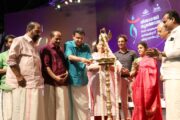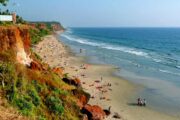The Himalayan trek can be a truly magical, life changing experience
Visiting the Himalayas has to be the pinnacle of tourism in India, for its sheer magical and unique feel. It’s almost an out-of-body experience.
The Ministry of Tourism titled recently conducted a webinar on ‘Trekking in the Himalayas: Magical Experiences’ highlighting the potential of tourism in the Indian Himalayan mountain. In the Indian Himalayas, one can see the pristine natural environment, snow-covered thick pine forests and numerous hidden surprises that can enthral and captivate trekkers from all over the world and across age groups and fitness levels.
Exploring the myriad trails, engaging with the friendly local villagers and taking in the wonders of the lakes, rivers, meadows are guaranteed to leave one with experiences of a lifetime to cherish and plan a trip again.
The webinar was moderated by Rupinder Brar, Additional Director General, Ministry of Tourism and presented by Anupam Singh, Co-Founder & Director, Shared Reach and Parag Gupta, Co-founder & Partner, The Bucket list Travel Company. The two presenters virtualised a mesmerising trip to different treks ranging from easy, moderate and difficult.
The famous quote by Bill Aitken: “The inescapable logic of desire leaves the mountain traveller no choice but to plan his next expedition to the very peak that may have just rejected vociferously the most single minded of advances” set the tone of the presentation.
Anupam Singh shared stories about every rock, peak, pristine natural beauty, amazing spectacular sunset, the colours of fall and the spring. Important tips for trekking were shared, such as –
* How to go about for Trekking- Understand the season, choosing a trek, Trek operator/guide
* Preparing for the trek – Fitness, Clothing, gear/equipment
* Be prepared for the unforeseen.
* On the trail, leave only footprints behind
* Survive to tell the tale about flora, fauna, big, small, tiny findings your way, snow
* Acute mountain sickness or altitude sickness
* Listen to guides and no need to take shortcuts
* Family trek is fun and interesting
The presenters shared the following famous treks which they called ‘Experiences of a Lifetime’.
- Kuari Pass (Uttrakhand) – (3800 m/12500 ft) is classified as an easy-moderate trek. Best time for this trek is from April to mid-June and in Spring from mid-September to Early November. The trek starts at 6,900 feet at Dhak and reaches a maximum altitude of 12,516 ft above mean sea level on the pass crossing day. On the Kuari Pass trek, you’ll be trekking for an average of 4-5 hours every day, except the pass crossing day which will be 8 hours long.
Delhi to Haridwar by rail or road. From Haridwar-Joshimath-Gulling top-Tali Forest camp-Kuari pass and back via Khullara top. Tali Forest Camp-Joshimath via Gurson Bugyal and Auli-Joshimath-Haridwar. The majestic and magical experience of Hathi Ghori Parbat, Dronagiri and Nanda Devi peaks can be enjoyed. One gets to see a lovely alpine lake on the way, snow covered mountains, golden meadows. A truly heavenly experience. - The Brahma Taal (3,855m/12,650 ft) takes one to a frozen alpine lake with mythology to match, it is an easy to moderate level of trek. The trek requires 6-7 days from Kathgodam to be completed. Best time for this trek is from December to February. The place is easily accessible from Delhi where one has to reach Kathgodam and then a drive from Kathgodam to Lohajung. The climb starts from BekalTaal, a frozen alpine lake and camps on the snow. The trails go through a forest and when you reach Telindi top, behold the enchanting views of the mighty Himalayas. Next day climb to Brahma Taal, the mystical lake where it is believed that Lord Brahma meditated. After a night on the snow, climb to Brahma Taal top, for enjoying the magnificent views. Next day, descend down directly to Lohajung and conclude the trek and depart to Kathgodam.
- The Harki Doon Valley (3,566m/11,700 ft) located at the Valley of Gods, in Garhwal region of Uttarakhand. It is a moderate level of trek and requires about 6 days from Dehradun. Best time for this trek is from April to June and September to December. From Dehradun, drive to Sankri, then onwards to Taluka, via Mussoorie. From Taluka the real trek begins upto Seema village and then from Seema climb up to Har ki Dun with an overnight stay at HarkiDoon. En-route one will witness the Swargarohini-I (6,525 m/20,512 ft) regarded as the Gateway to Heaven and is associated with the mythological tales of Mahabharata. The next day, one can directly descend to Seema, via the hanging village of Osla. The village has a historical temple wherein Duryodhana is being worshipped.
- The Fotoksar (4,100 m/16,000 ft) is a picturesque village in Ladakh. It is the part of the Lingshed-Padum trek (also known as The Great Zanskar trek)- not accessible for about 6 months every year due to heavy snows and avalanches. It is a moderate level of trek and requires 9-10 days from Delhi. The best time to visit is from June to October. There are options for homestays which would help in gaining local experience and supporting the local economy. From Delhi one can take flight to fly in at Leh (3,500 m/11,500 ft). It is advisable to acclimatize in Leh to prevent Acute Mountain Sickness (AMS). From Leh, drive to Lamayuru-Kargil road and reach the Wanla Village. After an overnight stay at the village, the next day proceed towards Yapola river and stay at Hanupatta village before climbing up to the SiSir La Pass at 4,890 m/16,000. Next day descending to the Fotoksar village, hanging off the edge of the cliff.
- The Roopkund(4,785m/15,700 ft) is another popular trek of Garhwal region, Uttarakhand. The level of difficulty lies from moderate to difficult and requires about 6 days from Kathgodam to Roopkund trek. Best time to do this trek is from December to February. A drive from Kathgodam to Lohajung. Trekking through Lohajung pass, crossing the Bedni river and overnight stay at Didana village. The next day a steep climb to Ali Bugyal (12,500ft), the largest meadow in Asia. With an overnight stay at Bedni Bugyal, the next day proceed to an amazing campsite next to glacier Bhaguwasa (14,100ft). The next day start an early morning trek up to Roopkund Lake. Visit to the lake side and return to the camp by lunch time. The next day descent to Lohajung. The mystery of skeletons lying in the Roopkund trek is that these are the skeletons of about 500 people who were crossing Roopkund caught in a lethal hailstorm around 820 AD. This fact has also been confirmed by the scientists by carbon dating.
Rupinder Brar, ADG Tourism stated that the trekking and experiencing the Himalayas are on the bucket list of many people, and therefore as soon as COVID-19 is subdued one could plan to experience and explore them. The thrill of adventure, the wonderful flora & fauna and the awe of the mysteries that the “Abode of Snow” hides can be a life changing experience.
The moderator informed trekkers to identify the tracks of their choice. For most of the destinations, there are local guides and also one can contact any tour operator who is a member of ATOAI, i.e. Adventure Tour Operators Association of India
As a responsible trekker, everyone has to abide by certain basic guidelines, as follows:
* Do not litter. Nothing other than your footprints should be left behind
* Keep the trek clean
* Do not disturb the animals and birds
* Don’t create any noise
* Privacy of the locals must be respected
* Respect the local customs and their place



